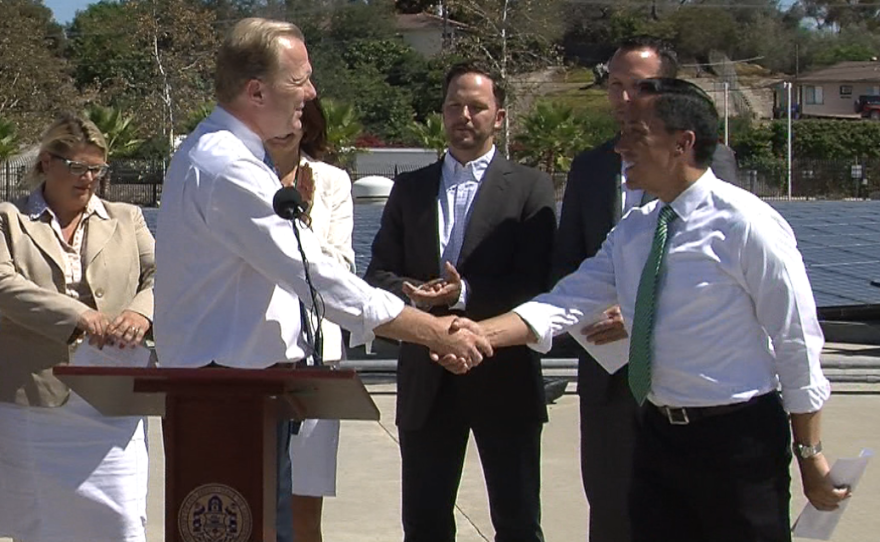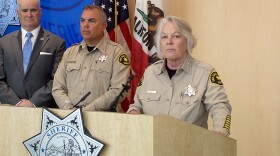A highly anticipated study that was supposed to show whether it would be possible and cheaper for San Diego to become energy independent missed its deadline by six months and was incomplete.
Now city officials are getting ready to start a bidding process for a second study. That means Mayor Kevin Faulconer’s climate action plan will likely move forward without information on whether it’s best for the city to stick with San Diego Gas & Electric for its energy needs or move toward taking control of its energy purchasing decisions.
The city didn’t pay for the incomplete and tardy study — leaving the funding of the report to an environmental nonprofit. Now it’s clear the city’s decision played out as an example of you get what you pay for.
Environmentalists began touting the anticipated study early this year.
It was meant to evaluate whether switching to an alternative energy program called community choice aggregation would cost residents more, less or the same as the current system, in which San Diego Gas & Electric purchases energy for all the residents and businesses in San Diego. Under community choice, the city makes those purchasing decisions, giving it more control over where its energy comes from, the cost and how much clean energy is in the mix.
Related story: SDG&E Takes Legal Step To Lobby On ‘Community Choice’
Nicole Capretz, executive director of the San Diego nonprofit Climate Action Campaign, and other environmentalists say the city needs to switch to community choice to reach its goal of using 100 percent renewable energy by 2035. The state only requires SDG&E to reach 50 percent clean energy by 2030.
"The minute that study goes public is the minute the war is on," Capretz told San Diego CityBeat in January.
Gretchen Newsom, political director for the San Diego chapter of the International Brotherhood of Electrical Workers, told Voice of San Diego: “We’re looking forward to seeing the results of the CCA feasibility study.” Newsom, a Democrat, has since announced she’s running for mayor.
A KPBS story from March said: “A study on whether the program would work in San Diego and how much it would cost will be released this month."
In June, Cody Hooven, the city’s sustainability manager, told KPBS the study was expected "any day now."
Finally, in September, the study was released, but it was incomplete. It found community choice aggregation could save ratepayers about 5 percent on their energy bills. But the analysis lacked detailed information and extended out only three years into the future. All of the calculations in the analysis also would need to be validated, according to the study’s own text. The groups that had been anticipating its release drew little attention to its findings.
So what happened? Emails from city officials and members of the city’s Sustainable Energy Advisory Board, which advises the City Council and mayor on energy policies, provide some insights. They suggest that Sam Golding, the consultant hired by the nonprofit to conduct the study, dropped the ball, missed deadlines, was unreachable for weeks at a time and finally turned in an incomplete analysis that was difficult to understand.
“Most of the discussion with Sam… was extremely disappointing,” wrote Dave Weil, deputy director for the city’s Environmental Services Department, in a March 17 email.
A month later, Weil wrote, “Although we attempted to contact Sam last week, we never did receive any word on the study. I will continue to try to contact him.”
“Unfortunately we have not received anything from Sam,” he wrote on May 15. “I spoke to him just about two weeks ago now and he promised he would have at least some kind of draft or an executive summary of what he has so far, but we have not received anything yet. I continue to call, text, email him and will probably do so again today to see if we can prod him into providing us something. Sorry it’s not better news.”
While the city of San Diego didn’t pay for the study, emails show city staff worked with Golding, were looking forward to his results and grew concerned once it became clear he wasn’t going to perform as expected.
Golding’s work examined the cost and feasibility of community choice aggregation, which plays a significant role in the city’s climate action plan. His results were expected early in the environmental review process of the plan, and instead were not factored in at all. The plan is expected to go before the City Council next month.
Golding declined to be interviewed for this story but wrote in an email that he did email Weil on three other occasions in March and April. He said his study was delayed because the analysis was a bigger project than anticipated.
"Predicting the financial performance of the City’s CCA proved an order-of-magnitude greater undertaking than had been anticipated at the outset of the project," he wrote. "Because of the City’s size, launching a CCA poses unique challenges that hadn't been encountered by the CCA industry at that time - we broke new ground in this regard, and our scope of work and timeline changed several times in response to the issues uncovered over the course of our research."
The nonprofit Protect Our Communities Foundation paid $40,000 for the study. Bill Powers, a mechanical engineer who sits on the group’s board, said the delayed study likely did impact the climate action plan.
“It would have been nice to be getting into that level of detail a year ago, that would have been preferred. However, it is what it is,” Powers said.
Golding wrote that his company went through the $40,000 by September 2014 and "had been doing our best to manage the expanded scope of work given these resource constraints."
As it was becoming clear Golding wasn’t going to produce a study, the city paid another firm to help with the community choice aggregation analysis.
The nonprofit Center for Sustainable Energy will be paid up to $65,000 to help hire a second company to conduct another community choice study. The city’s Sustainable Energy Advisory Board is currently discussing the bid for that study.
It was always the plan for the city to do a second study, Weil said. He declined to be interviewed for this story, and instead had the city’s communications department issue a statement.
“It was always the intent that the City would perform its own independent analysis of Community Choice Aggregation,” it read in part. “The City is currently developing the scope of work for the project with the Center for Sustainable Energy with the goal of issuing an RFP to hire an independent consultant.”
Powers confirmed this. Even if Golding’s work had been complete and on time, he said, its backing by an environmental nonprofit could lead to questions about its neutrality.
“The only reason we stepped in was because this is something a political jurisdiction should be doing, and we said if we don't do it no one's going to do it,” he said. “We didn't think we should be in the game at all frankly.”
If the city had initially funded its own study, he said, Protect Our Communities wouldn’t have paid for Golding’s. And if more money had been available at the beginning of the process, “we would have gotten a more complete study,” Powers said.
“More funds would have allowed us to go into greater depth on the study and complete a technical feasibility study,” he said.
So why didn’t the city fund its own study from the start?
Powers said it’s because community choice earned a negative connotation from a countywide study 10 years ago. One scenario in that study found community choice would cut county electricity bills by about 5 percent, but those savings wouldn’t come for a few years. An alternative scenario showed savings immediately, but it got little attention at the time.
While that study used old data that’s not relevant today, its results squelched the political will for another study, Powers said.
“We said no political entity in this region is going to spend any money looking at this,” he said. “So let's see if we can allocate the funds and find a competent consultant, get it out there and make the decision again.”
While the city didn’t pay for Golding’s study, it was highly involved in one aspect of it: obtaining consumer energy use data from SDG&E. Golding needed that information to analyze ratepayer costs, and the city had to sign an agreement with SDG&E to get that confidential energy data.
Former Mayor Bob Filner originally agreed to request the information, but then resigned from office amid a sexual harassment scandal. Interim Mayor Todd Gloria then stepped in and made the request.
Golding signed a nondisclosure agreement with SDG&E in April 2013 to access its data. If a new firm is hired to do a second study, the current mayor, Faulconer, may again have to request the SDG&E data.
Environmentalist Capretz acknowledged she highlighted Golding’s study early in the climate action plan process, but she said she never expected it to play a significant role in the development of the plan.
“We were always planning to not have a study before we passed the climate plan, so everything is moving according to the way we initially envisioned it,” she said.
Her focus has always been on getting the climate action plan passed, Capretz said.
“Once the city of San Diego passes its climate action plan, the legal clock starts ticking so that we are taking the steps necessary to hit these reductions we need in carbon emissions,” she said.
The climate action plan will go to the City Council’s Environment Committee on Nov. 30. If approved, it will go before the full council.






